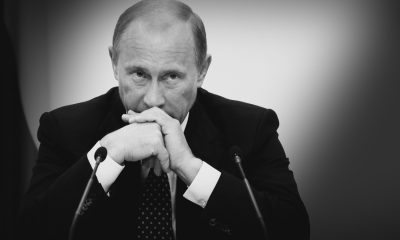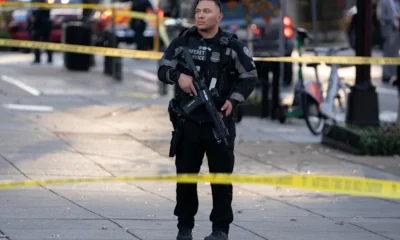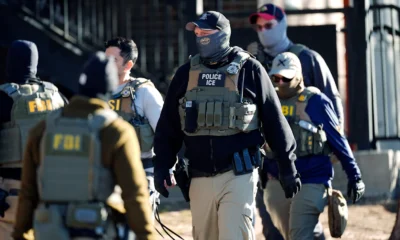Terrorism
Two National Guard Members Shot Near White House; Afghan Suspect Identified

President Donald Trump on Wednesday condemned the shooting of two West Virginia National Guard members near the White House as “an act of evil” and “an act of terror,” as authorities identified the suspected gunman as a 29-year-old Afghan national who entered the United States in 2021.
The two Guard members — a man and a woman — remained in critical condition after what officials described as a targeted ambush in downtown Washington. The shooting unfolded around 2:15 p.m. near the Farragut West Metro station, when the suspect rounded a corner and opened fire on the uniformed service members without warning, according to Metropolitan Police Executive Assistant Chief Jeffery Carroll.
“It appears … to be a lone gunman,” Carroll said. Fellow National Guard personnel nearby rushed toward the gunfire and subdued the suspect, who was also wounded and transported to a hospital.
The incident briefly placed the White House on lockdown and prompted a rapid response from federal and local agencies, including the FBI, ATF, U.S. Marshals Service and the Department of Homeland Security.
A suspect with asylum status granted in 2025
Multiple law enforcement officials identified the suspect as Rahmanullah Lakanwal, who arrived from Afghanistan in September 2021 and later applied for asylum. According to three officials familiar with the case, he was granted asylum in April 2025 — under the Trump administration.
Despite that timeline, Trump criticized the prior administration during a televised address, claiming the shooting underscored what he called “the single greatest national security threat facing our nation.” He said the U.S. should “reexamine every single alien from Afghanistan who has entered our country under Biden.”
Within minutes of Trump’s remarks, U.S. Citizenship and Immigration Services announced that all immigration processing related to Afghan nationals was suspended indefinitely pending a review of “security and vetting protocols.”
The FBI is investigating the attack as a potential act of international terrorism, officials said, though no motive has been confirmed.
Confusion over victims’ conditions
West Virginia Gov. Jim Justice initially said the Guard members had died, before later noting “conflicting information” about their conditions. Maj. Gen. Tim Seward, adjutant general of the West Virginia National Guard, credited the “swift, courageous” actions of other troops at the scene for stopping the gunman and preventing further casualties.
Washington Mayor Muriel Bowser said the shooter “appeared to target” the Guardsmen, who were among more than 2,100 personnel deployed to the capital as part of Trump’s federal takeover of D.C. law enforcement announced in August.
Political reverberations
Trump, speaking from Florida, said the attacker “will pay a very steep price,” while praising the Guard and law enforcement as “truly great people.”
At a separate event in Kentucky, Vice President JD Vance told troops that the nation was still seeking answers.
“It’s a somber reminder that soldiers … are the sword and the shield of the United States,” he said.
Defense Secretary Pete Hegseth said he would send an additional 500 National Guard personnel to Washington at Trump’s direction, calling the shooting a “cowardly, dastardly act.”
Gen. Steven Nordhaus, chief of the National Guard Bureau, said he and senior enlisted leaders were traveling to Washington to meet with the deployed troops. “We are devastated by this senseless act of violence,” he said.
Federal prosecutors and law enforcement officials are expected to release more details about the suspect and the investigation on Thursday.
Terrorism
After D.C. Ambush, U.S. Launches Largest Green Card Reassessment in Decades

The Biden-era resettlement of Afghan nationals is once again under fierce scrutiny after the U.S. Citizenship and Immigration Services announced a sweeping re-examination of green card holders from 19 “countries of concern.”
The move came less than 24 hours after a targeted shooting near the White House left one National Guard member dead, another critically wounded, and reignited a national debate over vetting failures.
USCIS Director Joseph Edlow said Thursday that President Donald Trump had ordered “a full-scale, rigorous reexamination” of every green card issued to immigrants from the designated countries, which include Afghanistan, Iran, Haiti, Syria, Venezuela, and others flagged in a June presidential proclamation for deficiencies in security screening.
The announcement marks the most expansive review of lawful permanent residents in decades, and it signals a dramatic shift in how the administration intends to treat thousands of immigrants who were admitted legally but are now subject to potential revocation if deemed improperly vetted.
A Shooting With Far-Reaching Consequences
The policy shift was triggered by Wednesday’s attack in Washington, D.C., when two National Guard members deployed under Trump’s federal policing initiative were ambushed near the Farragut West Metro station.
Twenty-year-old Specialist Sarah Beckstrom later died of her injuries. Staff Sergeant Andrew Wolfe, 24, remains in critical condition.
Federal investigators identified the suspect as 29-year-old Rahmanullah Lakanwal, an Afghan national who arrived in the United States in September 2021 under Operation Allies Welcome, the emergency evacuation program launched during the Taliban takeover.
A relative told NBC News that Lakanwal served in the Afghan Army for a decade, including alongside U.S. Special Forces in Kandahar. The CIA later confirmed he had worked with American intelligence as part of a partner force until the U.S. withdrawal.
He ultimately settled in Bellingham, Washington, with his wife and five children.
Investigators say Lakanwal drove across the country before carrying out what authorities describe as a deliberate ambush.
Trump: “We Must Re-Examine Every Single Alien” From Afghanistan
In a video statement Thursday evening, President Trump called the shooting “an act of terror” and criticized the Biden administration’s decision to admit tens of thousands of Afghans in 2021.
“We must now re-examine every single alien who entered from Afghanistan under Biden,” Trump said, calling the attack “a crime against our entire nation.”
Shortly after his remarks, USCIS announced that all immigration processing for Afghan nationals would be halted indefinitely while new vetting protocols are developed.
A Policy With Uncertain Reach
It remains unclear how many of the roughly 76,000 Afghans evacuated in 2021 — as well as thousands of green card holders from other listed countries — may be subject to reviews, interviews, or possible revocation proceedings.
Legal experts say the policy is likely to face legal challenges, though the administration has made clear it intends to pursue an aggressive reassessment of prior admissions.
Local officials, meanwhile, urged caution in assigning collective blame.
San Diego–based AfghanEvac, a major resettlement advocacy group, said Afghan wartime partners are among the most heavily vetted immigrants in the U.S. system. “This act should not be used to define or diminish an entire community,” the group said.
But Thursday’s developments reinforce how a single violent incident — especially when tied to a national security program — can reshape federal policy overnight.
For now, federal officials say the investigation into Lakanwal’s motive is ongoing, and that prosecutors are treating the case as a potential act of terrorism.
Somalia
Foreign Fighters Among Casualties in U.S.-Backed Raid on Somali ISIS Cell

U.S. special operations forces joined Puntland’s elite counterterrorism units in a major assault on an Islamic State stronghold in Somalia’s Balade Valley, according to Somali security officials briefed on the operation.
The coordinated strike—one of the most significant joint actions in Puntland in recent years—unfolded overnight, when U.S. troops were inserted into the rugged valley aboard MH-60 helicopters while MQ-9 Reaper drones conducted precision strikes on suspected militant compounds in the Habarbakuuje and Mareero areas.
Security officials said the targeted enclave had served as a fortified hideout for a small but hardened ISIS cell, including foreign fighters from Syria, Turkey and Ethiopia.
The assault triggered an intense gun battle that lasted between two and four hours as militants attempted to repel advancing forces from defensive positions carved into the mountainsides.
Early assessments indicate that a senior ISIS commander and several of his aides were killed, with officials estimating between five and ten militant casualties.
Joint forces also destroyed weapons stockpiles and equipment believed to support the group’s gold-mining operations—an increasingly critical revenue source fueling ISIS activities in Puntland.
Puntland authorities have vowed to dismantle ISIS networks across the region by the end of 2025, and U.S. support has expanded in recent months.
American drones and intelligence assets have targeted ISIS hideouts across the Bari mountains, helping push fighters from their traditional strongholds into more isolated terrain.
A Puntland security official said the latest operation reflects “tightened coordination” with U.S. forces and forms part of a broader campaign to degrade ISIS’ financial pipelines and operational reach.
Washington has not yet publicly commented on the strike, but U.S. counterterrorism operations in northern Somalia are typically authorized under long-standing missions aimed at disrupting transnational extremist groups.
Terrorism
New U.S.-Backed Study Warns Al-Shabaab May Be Able to Seize Mogadishu

Analysis: U.S.-Backed Warning Says Al-Shabaab’s Advance Now Threatens Mogadishu as Somalia’s Federal Order Fractures.
A new assessment from the Africa Center for Strategic Studies warns that al-Shabaab’s sweeping gains across central Somalia have brought the militant group closer to Mogadishu than at any point in more than a decade, raising the once-unthinkable prospect that the capital could fall if the political crisis deepens and security forces continue to erode.
The brief — authored by Horn of Africa analyst Matt Bryden — argues that al-Shabaab’s advances have coincided with a rapid breakdown of cooperation between Villa Somalia and federal member states, creating a security and political vacuum that the militants have exploited with increasing speed.
According to the report, al-Shabaab now controls roughly a third of Somali territory and has pushed to within 50 kilometers of the capital after reclaiming nearly all areas lost during the 2023 government offensive.
Diplomats have reportedly evacuated nonessential staff to Nairobi as militants set up roadblocks on key approaches to Mogadishu, pausing only to consolidate control in Middle Shabelle.
An October suicide raid on the National Intelligence and Security Agency — less than a kilometer from the presidential compound — underscored what the brief calls “the capital’s extraordinary vulnerability.”
The report portrays Somalia’s security forces as exhausted and overstretched. Defense officials recently acknowledged that up to 15,000 soldiers have been killed or wounded in three years.
The army’s reliance on elite units, chronic corruption and clan favoritism, and the collapse of momentum following last year’s offensive have left the government struggling to hold territory without foreign backing.
Even that support is faltering. The African Union Support and Stabilization Mission, AUSSOM, has received only a fraction of its budget, carrying more than $100 million in arrears.
Without emergency funding, the mission may be forced to retreat to guarding only the airport, port, and Mogadishu’s diplomatic enclave — leaving the capital exposed.
The security crisis is mirrored by a political rupture that Bryden describes as the unraveling of Somalia’s federal bargain. The Provisional Constitution envisioned power-sharing between Mogadishu and member states, anchored by four major port economies.
But successive presidents have concentrated power at the center, a trend the brief says reached its peak under President Hassan Sheikh Mohamud’s second term, with controversial constitutional amendments and political maneuvering ahead of the 2026 elections.
Puntland and Jubaland have suspended cooperation, withdrawn recognition of federal authority, and warned that any extension of Hassan Sheikh’s term would trigger a constitutional crisis.
Opposition groups say the presidency’s current trajectory risks splitting the country into rival governments — one centered in Mogadishu, another around the more stable administrations in Puntland and Jubaland.
The report warns that even without a battlefield takeover, Somalia could drift toward an illiberal Islamist state. Political Islamists — including factions linked to the Muslim Brotherhood and Salafi movements — already occupy key positions across government and religious institutions.
Al-I’tisaam’s influence over major businesses, religious networks, and parts of the security apparatus is growing, while new constitutional amendments shaped by Salafi clerics could undermine human rights protections.
Foreign involvement is further amplifying domestic fractures. Qatar and Türkiye back Islamist-aligned leaders in Mogadishu and have become deeply embedded in the capital’s security and infrastructure.
Türkiye now manages Mogadishu’s port and airport, trains elite security units, and has signed extensive maritime and energy deals — including plans for a missile-testing and space-launch site on the coast.
The UAE, Ethiopia, and Kenya, meanwhile, maintain closer ties with Somaliland, Puntland, and Jubaland. Emirati-managed ports at Berbera and Bosaaso have strengthened regional economies, while Ethiopian and Kenyan security forces depend on their northern partners for border stability.
Somaliland — long operating as a de facto independent state — stands at the center of this geopolitical map.
The brief notes that if southern Somalia collapses further or falls to al-Shabaab, international pressure to revisit Somaliland’s status may intensify, echoing a 2005 African Union mission that described its case for recognition as “historically unique and self-justified.”
The report outlines two potential paths. One is an emergency political reset: a government of national unity, a return to the original constitutional text, an indirect election by May 2026, and a revival of the security architecture that places federal member state forces and community militias at the center of the counterinsurgency.
The alternative is a collapse-and-containment scenario in which al-Shabaab captures Mogadishu — along with its port revenues and military hardware — forcing Puntland, Jubaland, Hiiraan, and allied administrations to form a provisional government elsewhere with backing from Ethiopia, Kenya, the UAE, and Western partners.
The brief concludes that Somalia’s fate will be determined less by what happens on the battlefield and more by whether political leaders can salvage the federal compact. Without cooperation, it warns, the black flag Somalia fought for decades to remove from its capital could return — this time backed by the country’s own fragmentation.

Terrorism
Exclusive: Puntland’s Operation Hilaac Fails to Cut ISIS Lifeline

Militants Thrive Off the Drought: ISIS Buys Goats and Cows to Survive in Al Miskaad Mountains.
Security officials in Puntland say Islamic State militants entrenched in the Al Miskaad Mountains continue to receive livestock supplies from local herders, exposing the persistent economic and logistical lifelines that have allowed the group to endure despite an ongoing regional offensive.
According to security sources, ISIS fighters purchase animals from nomadic families near the Baalade Valley, often offering two to three times the market price.
The inflated payments have drawn drought-stricken pastoralists struggling with debt, creating a covert supply chain that sustains the group’s mountain units even as Puntland forces tighten operations under the U.S.-backed Operation Hilaac campaign.
Since its launch in late 2024, Operation Hilaac has retaken multiple caves and outposts across the Golis and Al Miskaad ranges.
Yet officials acknowledge that small ISIS cells remain active, exploiting the rugged terrain and local vulnerabilities to maintain mobility and resupply networks.
In several recently reclaimed villages, Puntland troops discovered fresh slaughter sites believed to have been used by ISIS fighters.
The finds have reinforced assessments that the group still depends on local commerce and informal trade links with families living in remote settlements.
Regional authorities have repeatedly warned residents against providing material support or maintaining ties with ISIS.
Last month, Puntland’s Interior Ministry ordered the evacuation of Tasjiic and nearby villages in Bari region over concerns of collaboration, though the order stalled after residents protested that they had nowhere to relocate.
Fighting has intensified around the Baallade Valley and nearby water sources such as the Baarakalaah well. Puntland officials confirmed casualties among their forces but did not release figures.
ISIS claimed to have repelled six assaults and killed ten Puntland troops — a claim that remains unverified.
U.S. airstrikes have played a growing role in supporting Puntland’s campaign.
In February, authorities reported that American strikes killed 46 ISIS militants in the Al Miskaad range, while in July, Puntland forces captured Abdiweli Mohamed Aw Yusuf, the group’s finance and foreign-relations chief, who had been sanctioned by the U.S. Treasury as a Specially Designated Global Terrorist.
Despite heavy losses, analysts estimate ISIS retains roughly 100 fighters scattered across the Habley Mountains and Baallade Valley.
The continued flow of livestock and cash from impoverished herders underscores the enduring difficulty of isolating militant cells in Somalia’s harsh northern highlands.
EDITORIAL ANALYSIS
Washington’s Dangerous Double Game in Somalia
Terrorism
U.S. Mission Decimates Al-Shabaab Command in Middle Shabelle
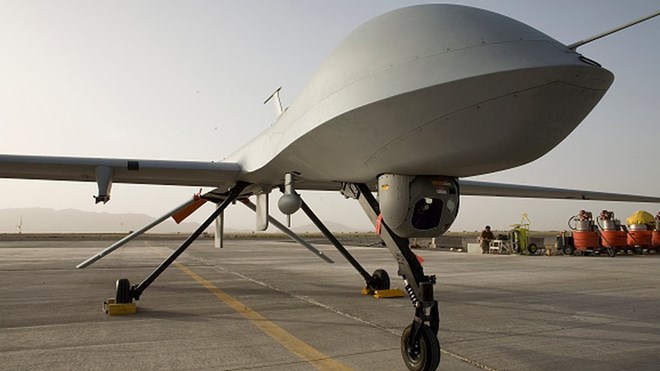
Senior Western intelligence sources confirm high-value leadership figures were targeted in a massive, coordinated air campaign near El Baraf, reaffirming that the most decisive counter-terrorism leverage in Somalia remains deployed from outside the dysfunctional political matrix of Mogadishu.
Late last night, the air over the Middle Shabelle region became a proving ground for the most focused counter-terrorism mission in the Horn of Africa.
Multiple, powerful airstrikes hammered Al-Shabaab positions in the vicinity of the El Baraf district. The impact was reportedly massive, with concussive force heard miles away, signaling a sustained and highly kinetic operation.
While the Federal Government of Somalia has remained conspicuously silent on the operation, multiple independent and local media reports confirm the strikes were executed by warplanes—consistent with the operational footprint of U.S. Africa Command (AFRICOM) and its unmanned aerial capabilities.
Reliable intelligence analysis suggests the strikes were not aimed at low-value fighting units or static fortifications. Rather, the deliberate, double-tap nature of the attack confirms a precise, high-value targeting mission.
Senior security officials familiar with coalition operational protocols indicate that the areas around El Baraf targeted were known to serve as a command and control nexus for Al-Shabaab’s operational leadership in central Somalia.
This region, strategically located near supply lines and known hideouts, is frequently utilized for planning major offensives.
Intelligence sources speculate the strikes aimed to eliminate critical mid- to senior-tier commanders responsible for finance, recruitment, and external attack planning.
Such targets, if confirmed killed, create immediate operational paralysis, forcing the terrorist group to spend crucial time and resources restructuring its hierarchy rather than planning attacks.
The U.S. counter-terrorism mission utilizes this surgical pressure to degrade the group’s organizational resilience and deny it safe harbor.
This successful, high-impact aerial operation throws into stark relief the fundamental difference in operational capability between the focused U.S. counter-terrorism strategy and the broader, more politicized ground efforts currently underway in Somalia.
The intelligence-driven, precision strike capability—often deploying stealth assets like drones—bypasses the federal-state rivalries, logistical nightmares, and corruption that plague ground forces.
It demonstrates that the most effective tool against a mobile, decentralized insurgency like Al-Shabaab is the persistent denial of secure operating space, executed by external partners who are unburdened by Somalia’s internal political paralysis.
The continued use of these kinetic strikes serves as an unambiguous policy declaration: Al-Shabaab will be pursued relentlessly, regardless of the pace of Somali state-building.
The fallout from this targeted strike will ripple through both the terrorist network and the political landscape:
The loss of key commanders creates operational confusion, forcing the group to fragment its leadership and rely on less experienced commanders, degrading their ability to mount sophisticated regional attacks.
The heavy nature of the strikes signals to both Al-Shabaab and regional players (including rivals like Ethiopia and new entrants like Egypt) that the U.S. counter-terrorism commitment to the Horn of Africa remains primary, decisive, and fully operational.
The U.S. mission, though often operating in the shadows, consistently delivers the high-impact security gains that the political theatre in Mogadishu struggles to consolidate.
The heavy airstrikes near El Baraf underscore that the most important security victories in Somalia are won from above, driven by intelligence, and executed with a precision that few regional actors can match.
Terrorism
Airstrike Kills Founding al-Shabaab Commander in Middle Jubba
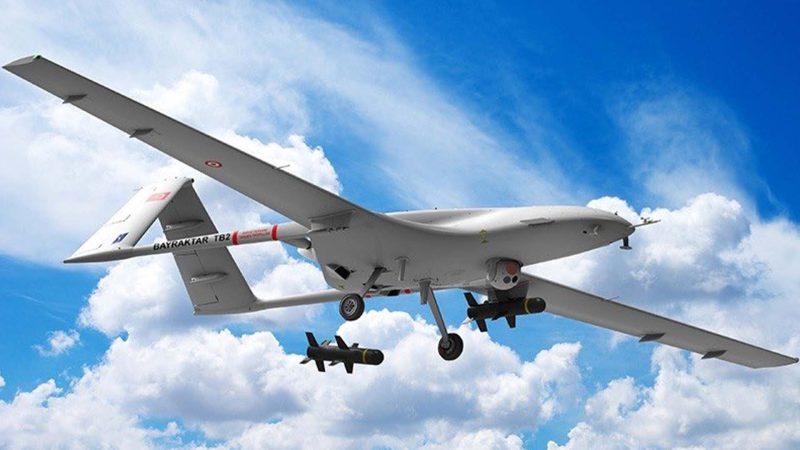
Somali government says Mahmoud Abdi Hamud, alias Jaafar Gurey—a key architect of al-Shabaab’s intelligence and finance network—was killed in a precision airstrike targeting Bu’aale.
A Somali airstrike in Middle Jubba has killed Jaafar Gurey, one of al-Shabaab’s founding members and a senior figure behind its intelligence and financial operations, as the government intensifies its offensive against the militant group.
A founding member of al-Shabaab, Mahmoud Abdi Hamud—better known by his nom de guerre Jaafar Gurey—was killed in a Somali government airstrike in the Middle Jubba region, officials confirmed Monday.
The strike, carried out on the night of October 26 and targeting the militant stronghold of Bu’aale, marks a major blow to the group’s upper leadership.
Somalia’s Defence Ministry said Gurey played a pivotal role in the group’s formation, serving as both financier and strategist during its early years.
“Over the years, he held several senior positions, including Head of External Security, Head of Leadership Security, and Head of Intelligence Tracking—all tied to the group’s espionage and assassination operations,” the ministry said.
Security sources say Gurey was one of the few remaining veterans linked to al-Shabaab’s original leadership circle under the late Ahmed Abdi Godane.
Together, they orchestrated financial schemes that included extorting funds from regional companies—including an Ethiopian contractor—to bankroll the group’s initial expansion.
The airstrike is part of a broader offensive aimed at dismantling al-Shabaab’s command structure across southern and central Somalia.
It follows a string of recent operations by the National Intelligence and Security Agency (NISA), which in September announced the killing of senior commander Abdi Hiiray and, earlier, Mohamed Abdi Dhiblawe—the alleged mastermind behind the March attempt on President Hassan Sheikh Mohamud’s convoy in Mogadishu.
Al-Shabaab, which has waged an insurgency for over sixteen years, continues to rely on asymmetric warfare—suicide bombings, targeted assassinations, and propaganda—to undermine government authority.
But the death of Gurey underscores a mounting attrition campaign targeting the group’s original architects—men whose operational knowledge once made al-Shabaab one of Africa’s most resilient militant networks.
Officials say the operation in Bu’aale sends a clear message: the Somali state is no longer hunting foot soldiers—it is systematically eliminating the architects of terror.
Terrorism
Somali Militants Linked to Mozambique’s Bloody Insurgency

A new Mozambican government report has revealed that Somali nationals are among foreign fighters implicated in eight years of terror attacks across the country’s northern Cabo Delgado province — a region that has become one of Africa’s most violent jihadist battlegrounds.
Authorities in Maputo confirmed the opening of 918 terrorism-related cases, with 724 individuals accused of direct involvement in the wave of attacks that began in 2017.
Among them are 105 foreign fighters, primarily from Somalia, Tanzania, Burundi, Malawi, Kenya, and South Africa — pointing to a transnational jihad network stretching from the Horn of Africa to the southern Indian Ocean.
So far, 462 suspects have been convicted, receiving prison sentences ranging from 2 to 30 years, underscoring the government’s determination to dismantle what it describes as “foreign-fueled extremism.”
According to data from the Armed Conflict Location & Event Data Project (ACLED), the Cabo Delgado insurgency has claimed over 6,200 lives, including more than 2,600 civilians, and displaced over 90,000 people.
Many of the displaced have fled to neighboring provinces such as Balama, Mocímboa da Praia, Montepuez, Chiúre, and Memba, where humanitarian needs remain acute.
Security analysts believe that Islamic State–affiliated cells operating in northern Mozambique are increasingly recruiting and embedding foreign militants from East Africa, with Somalia playing a key logistical and ideological role.
Intelligence assessments suggest that veterans of al-Shabaab networks have crossed into southern Africa through Kenya and Tanzania, bringing financing, combat experience, and ideological training to local insurgents.
The Mozambican government insists it remains committed to restoring peace, vowing to “secure the nation’s sovereignty and protect its citizens.”
International partners — including the Southern African Development Community (SADC) and Rwandan security forces — continue to provide counterinsurgency support in the region.
The revelations of Somali involvement, however, mark a new and troubling chapter in Africa’s jihadist landscape: a continental web of militancy that now links Somalia’s al-Shabaab, IS-Mozambique, and transnational extremist financiers.
For regional intelligence officials, the warning is clear — Cabo Delgado is no longer just Mozambique’s war; it’s Africa’s next jihad frontier.
-

 Analysis9 months ago
Analysis9 months agoSaudi Arabia’s Billion-Dollar Bid for Eritrea’s Assab Port
-

 Opinion17 years ago
Opinion17 years agoSomaliland Needs a Paradigm Change: Now or Never!
-
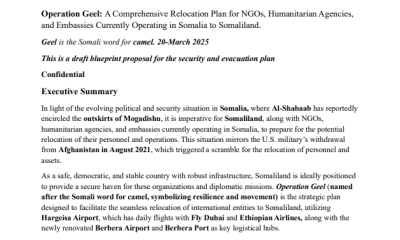
 ASSESSMENTS8 months ago
ASSESSMENTS8 months agoOperation Geel Exposes the Truth: International Community’s Reluctance to Embrace Somaliland as a Strategic Ally
-

 Somaliland10 months ago
Somaliland10 months agoSomaliland and UAE Elevate Ties to Comprehensive Strategic Partnership
-

 Africa2 years ago
Africa2 years agoHow Somaliland Could Lead the Global Camel Milk Industry
-

 Analysis7 months ago
Analysis7 months agoFrom Cell to Summit: The Prisoner Who Became Syria’s President
-
Analysis8 months ago
How an Israeli Strike on Iran’s Nuclear Program Could Play Out
-
Analysis2 years ago
Iran escalates conflict, attacking Israel; US forces help Israel to intercept Iranian projectiles




